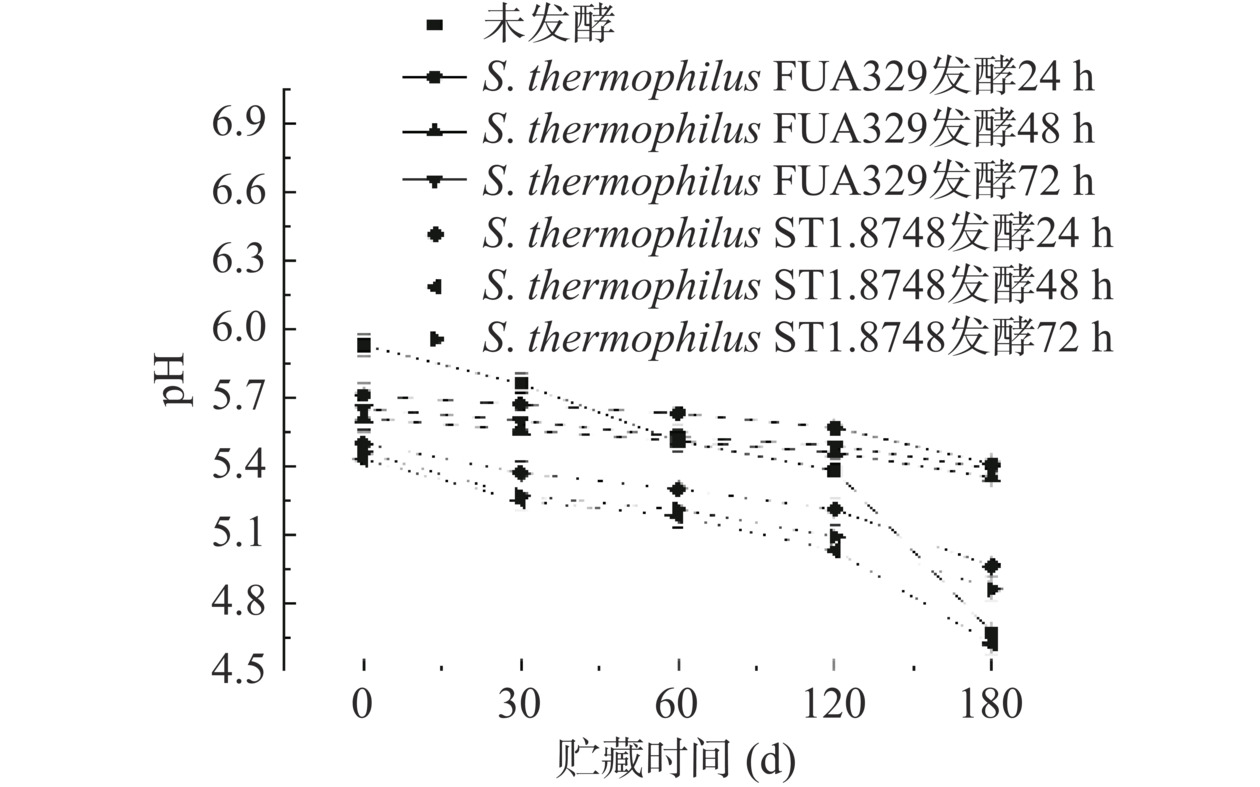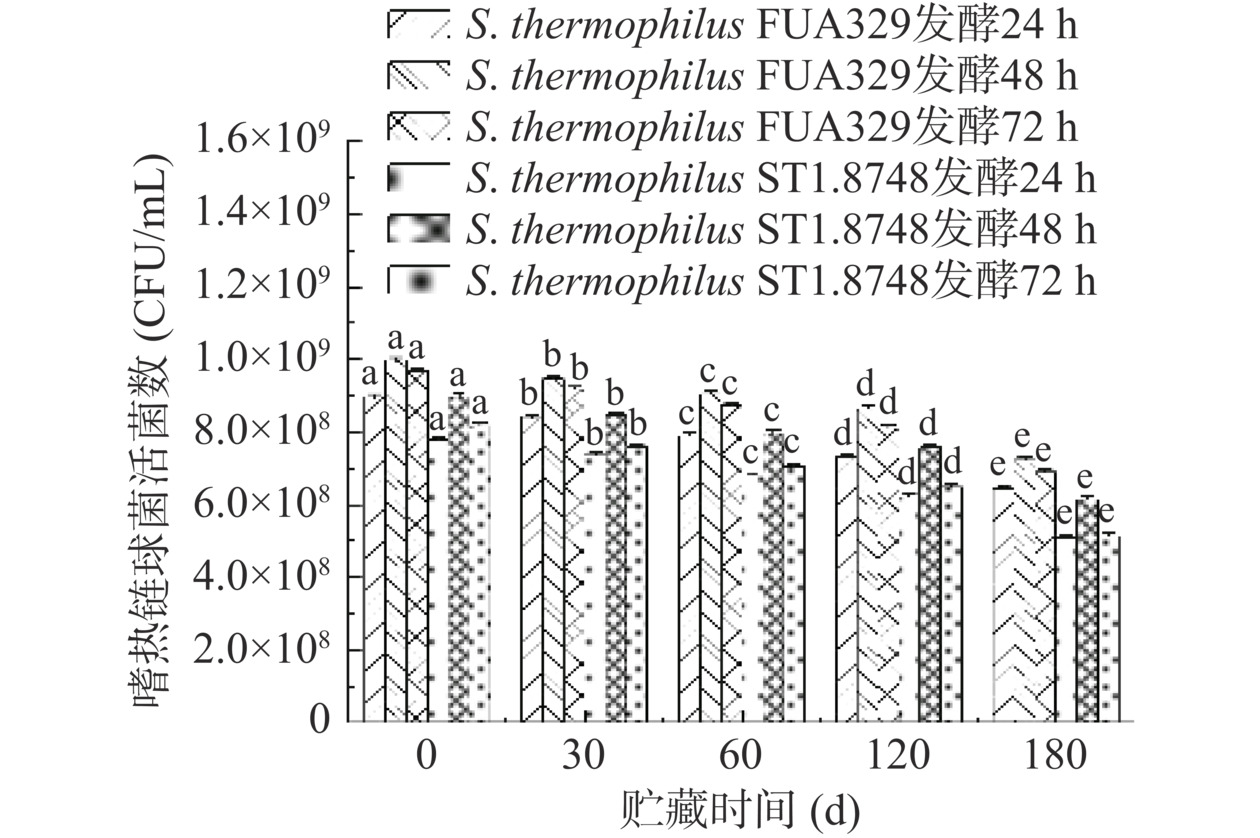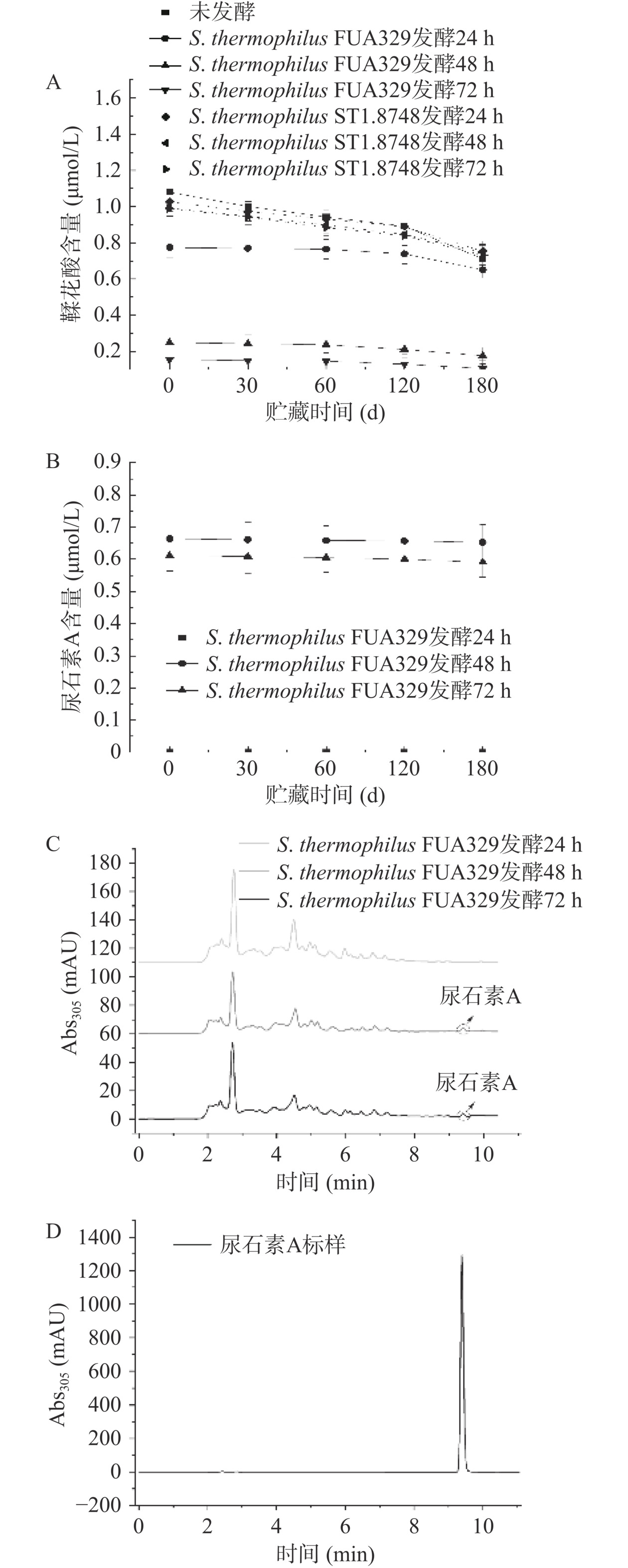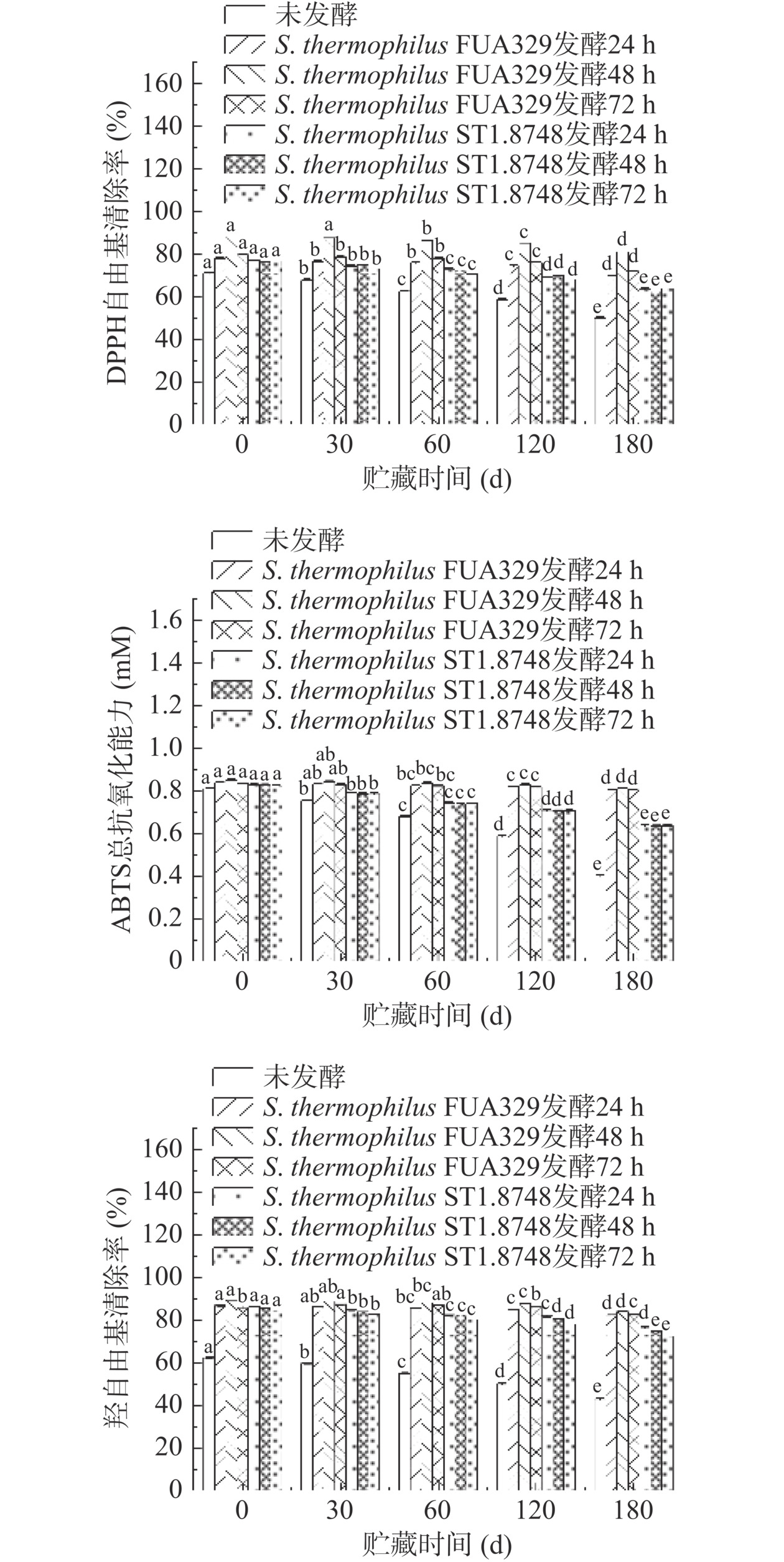Fermentation of Green Tea Extract by Streptococcus thermophilus FUA329 and Evaluation of Storage Characteristics
-
摘要: 为了评价嗜热链球菌发酵对绿茶浸提液及其贮藏特性的影响,本研究利用嗜热链球菌Streptococcus thermophilus FUA329和嗜热链球菌S. thermophilus ST1.8748(对照组)分别对绿茶浸提液进行发酵,在4 ℃贮藏0、30、60、120和180 d后,以pH、活菌数、茶多酚含量、鞣花酸含量、尿石素A含量为主要评价指标,结合抗氧化活性,对发酵绿茶浸提液的贮藏品质进行评价。结果表明,相比S. thermophilus ST1.8748对照组,贮藏期内S. thermophilus FUA329发酵绿茶浸提液的pH在5.39~5.71之间;活菌数在48 h时最高为9.97×108 CFU/mL;茶多酚含量逐渐降低;鞣花酸含量趋于稳定状态;尿石素A在48 h时产生,其浓度为0.664 μmol/L;抗氧化活性始终维持在较高水平。综上所述,S. thermophilus FUA329发酵绿茶浸提液,可以显著延缓绿茶浸提液贮藏过程中品质下降和营养成分损失。
-
关键词:
- 绿茶 /
- 嗜热链球菌FUA329 /
- 尿石素A /
- 抗氧化活性 /
- 贮藏特性
Abstract: In order to evaluate the effect of Streptococcus thermophilus fermentation on green tea extract and its storage characteristics, this study used Streptococcus thermophilus FUA329 and S. thermophilus ST1.8748 (control group) to conduct experiments on green tea extracts. After fermentation and storage at 4 ℃ for 0, 30, 60, 120 and 180 d, pH, viable bacterial count, tea polyphenol content, ellagic acid content, and urolithin A content were used as the main evaluation indicators, combined with anti-oxidation activity to evaluate the storage quality of fermented green tea extract. The results showed that compared with the S. thermophilus ST1.8748 control group, the pH of S. thermophilus FUA329 fermented green tea extract during the storage period was between 5.39 and 5.71. The highest number of viable bacteria at 48 h was 9.97×108 CFU/mL. The content of tea polyphenols gradually decreased and the ellagic acid content tended to be stable. Urolithin A was produced at 48 h, and its concentration was 0.664 μmol/L. The antioxidant activity was always maintained at a high level. In summary, S. thermophilus FUA329 fermented green tea extract can significantly delay the quality decline and nutrient loss of green tea extract during storage. -
绿茶(green tea)以其鲜爽的品质和优异的健康功效,深受国内外消费者喜爱,是我国生产量与消费量最高的茶类[1−3]。2022年,我国绿茶产量185.38万吨,中国绿茶内销量131.1万吨,其中出口31.29万吨[4]。绿茶中的多种多酚类化合物,通常被称为茶多酚(tea polyphenols,TP)[5]。茶多酚具备多种生物活性,如抗氧化[6]、抗癌[7]、预防龋齿[8]、降低血脂、预防心血管疾病[9]等。鞣花酸(ellagic acid,EA)是绿茶中富含的一种天然多酚,主要以其缩合形式鞣花单宁(ellagitannin,ET)存在。由于鞣花酸溶解度低,导致其生物可利用率较低。人类的肠道微生物群可以将鞣花酸转化为尿石素类物质,主要包括尿石素A(urolithin A,UA)、尿石素B(urolithin B,UB)和尿石素C(urolithin C,UC)[10]。尿石素比鞣花酸更容易吸收,特别是尿石素A具有如防止肌肉衰退[11]、抗癌[12]、抗氧化[13]、抗炎[14]、抗脑老化[15]、抗肥胖[16]等多种生物活性。但是,不同人群肠道微生物转化鞣花酸生成尿石素的能力不同,仅有约40%的30岁以上的人具有转化鞣花酸生成尿石素A的能力[17],且随着年龄的增长,比例逐年下降。因此,有关公司开发了化工合成的尿石素A作为营养补充剂,受到人们的青睐。如果筛选得到转化鞣花酸生成尿石素A的菌株,则可以利用微生物发酵制备尿石素A弥补工业制备尿石素A产品具有副产物及危害环境的不足,也可以制备含有尿石素A的饮品如茶饮品,提高发酵茶饮品的保健功效。
另外,绿茶属于不发酵茶,耐贮性不佳,贮藏后容易颜色发暗、口感发涩,品质和营养成分严重降低,导致市场竞争力下降。而绿茶浸提液在贮藏的过程中,主要成分之间会发生氧化络合作用,导致其颜色变褐,并形成沉淀物使其变得浑浊,影响外观品质以及营养价值。因此,绿茶浸提液保鲜技术成为研究热点。绿茶浸提液的保鲜方法主要是通过优化生产工艺以及添加食品添加剂来保证其在贮藏期内的品质[18−19]。但是,大多方法都是采用单因子保鲜方法,各方法都有自己的优缺点,目前的保鲜方法尚未达到市场要求,因此需要开发新型保鲜技术。有研究发现乳酸菌(lactic acid bacteria,LAB)可以利用茶叶鲜叶、茶叶浸提液或茶叶副产物作为发酵底物,合成或降解多种活性成分,用来改善和形成茶叶产品的风味品质,提高产品的功能特性,提高茶叶底物生物转化的利用率,乳酸菌发酵有望成为绿茶浸提液保鲜技术之一[20]。但是,乳酸菌发酵茶叶浸提液用于茶叶浸提液保鲜的研究鲜有报道。如果利用转化鞣花酸生成尿石素A的乳酸菌对绿茶浸提液进行发酵,既可以将绿茶浸提液中的鞣花酸转化为尿石素A,提升绿茶的保健功效,也有望提高绿茶浸提液的保质期,开发新型茶饮品,提升绿茶饮品的市场竞争力。
本研究组报道了源自人母乳的S. thermophilus FUA329,该菌可体外发酵转化鞣花酸生成尿石素A[21]。本文以绿茶浸提液为原料,利用菌株S. thermophilus FUA329对其进行发酵,以S. thermophilus ST1.8748为对照。发酵绿茶浸提液在4 ℃贮藏后,对其pH、活菌数、茶多酚含量、鞣花酸含量、尿石素A含量以及抗氧化活性进行测定,评价发酵绿茶浸提液贮藏过程中品质变化,旨在探讨微生物发酵绿茶新产品开发的可行性,从而为茶叶资源的有效利用和茶产业结构的优化提供科学依据。
1. 材料与方法
1.1 材料与仪器
云雾茶 连云港市天源茶业有限公司;嗜热链球菌S. thermophilus FUA329 本研究室保藏;嗜热链球菌S. thermophilus ST1.8748 中国普通微生物菌种保藏管理中心;厌氧基础培养基(anaerobic basal broth,ABB) 上海瑞楚生物技术有限公司;茶多酚标准品、鞣花酸标准品、尿石素A标准品 美国Sigma-Aldrich公司;甲醇、甲酸、乙腈 色谱纯,上海阿拉丁生化技术公司;硫酸亚铁、酒石酸钾钠、磷酸氢二钠、磷酸二氢钾 分析纯,国药集团化学试剂有限公司;DPPH自由基清除能力试剂盒、ABTS法总抗氧化能力试剂盒、羟自由基测定试剂盒 南京建成生物工程研究所。
LDZX-50L立式高压蒸汽灭菌锅 上海申安医疗器械厂;SW-CJ-1FD超净工作台 苏州市华宇净化设备有限公司;S210数字pH计 瑞士梅特勒-托利多公司;GRX-9203A微生物恒温培养箱 上海福玛实验设备有限公司;A20厌氧工作站 英国Don Whitley Scientific;A51119600DPC全波长酶标仪 美国Thermo Scientific公司;1260系列高效液相色谱仪 美国Agilent公司。
1.2 实验方法
1.2.1 菌株种子液制备
取−80 ℃甘油保藏的S. thermophilus FUA329进行活化,三区划线于ABB固体培养基,37 ℃倒置培养至长出单菌落,挑单菌落接种于ABB液体培养基,在厌氧工作站中37 ℃厌氧发酵48 h后作为种子液备用,S. thermophilus ST1.8748种子液制备同上。
1.2.2 绿茶浸提液制备与发酵
取1 g绿茶样品,按茶水比1:70,80 ℃,浸提50 min,8层纱布过滤,滤液过0.22 µm滤膜过滤除菌,得到绿茶浸提液。以3%(V:V)接种量分别将活化的S. thermophilus FUA329菌液以及S. thermophilus ST1.8748接种至50 mL绿茶浸提液中,添加3%果葡糖浆,37 ℃厌氧培养24、48、72 h[22],得到发酵绿茶浸提液样品。
1.2.3 pH测定
将发酵好的绿茶浸提液在4 ℃下分别放置0、30、60、120和180 d后,采用pH计测定样品pH。
1.2.4 嗜热链球菌活菌数的测定
嗜热链球菌活菌数测定参照GB 4789.35-2016《食品安全国家标准 食品微生物学检验 乳酸菌检验》进行。
1.2.5 茶多酚含量的测定
茶多酚含量的测定用酒石酸亚铁比色法[23]。在25 mL容量瓶中加入5 mL样品、4 mL水和5 mL酒石酸亚铁溶液,混匀,用pH7.5磷酸缓冲液定容至25 mL。按照上述相同步骤,用5 mL水替换样品作为空白对照。使用酶标仪在540 nm波长下测定吸光值。结果基于茶多酚标准曲线校准表示。准确称取0.05 g茶多酚标准品,用纯净水溶解,定容至10 mL,混匀。分别移取0、0.1、0.2、0.3、0.4、0.5 mL至25 mL试管中,加水补至10 mL,再加入5 mL酒石酸亚铁溶液,混匀后加入pH7.5磷酸缓冲液溶液至25 mL,充分混合。将上述混合标准溶液在540 nm波长下测定吸光值。以吸光度值为纵坐标,茶多酚含量(µg/g)为横坐标,绘制标准曲线,作图得到茶多酚浓度(X)与吸光度值(Y)的线性回归曲线,回归方程为Y=0.0094X−0.01,决定系数R2=0.999,表明线性关系良好。
1.2.6 高效液相色谱法测定鞣花酸以及尿石素A的含量
采用高效液相色谱(high performance liquid chromatography,HPLC)法,分析S. thermophilus FUA329绿茶浸提液发酵后样品的鞣花酸和尿石素A的含量。将1 mL样品混合有机溶剂(乙腈:水:甲酸=80:19.9:0.1,V:V:V),然后通过0.22 μm的膜过滤器过滤到HPLC样品瓶中。色谱分析采用色谱纯乙腈(A相)和含1%甲酸的水溶液(B相)作为流动相,色谱柱型号为ZORBAX SB-C18(250×4.6 mm,5 μm,Agilent),流速为1 mL/min。柱温35 ℃,进样体积20 μL,采用梯度洗脱模式,具体梯度如下:0~15 min,20%~70% A;15~20 min,70%~95% A;20~21 min,95%~100% A;21~24 min,100%~20% A;24~25 min,20%~20% A。在305 nm进行色谱分析[24]。
1.2.7 抗氧化活性的测定
1.2.7.1 DPPH自由基清除率的测定
采用南京建成生物工程研究所DPPH自由基清除能力试剂盒(A153-1-1),步骤参考说明书测定样品DPPH自由基清除率。其原理为根据DPPH自由基有单电子,在517 nm处有强吸收,其醇溶液呈紫色的特性。自由基清除剂与其单电子配对而使其在517 nm的光吸收度降低,颜色变浅[25]。
1.2.7.2 ABTS总抗氧化能力的测定
采用南京建成生物工程研究所ABTS法总抗氧化能力试剂盒(A015-2-1),步骤参考说明书测定样品ABTS总抗氧化能力。其原理为体系中的氧化剂会将ABTS氧化成绿色的ABTS+·,当存在抗氧化物时,会抑制ABTS的氧化,阻止ABTS+·产生。ABTS+·在734 nm或405 nm的波长下会有强烈的吸收峰值,因此,测定吸光度即可直接计算出样品的总抗氧化能力[26]。选择Trolox作为参考,它是维生素E的类似物,其抗氧化能力与维生素E相近。
1.2.7.3 抑制羟自由基能力的测定
采用南京建成生物工程研究所羟自由基测定试剂盒(A018-1-1),步骤参考说明书。其测定原理为Fenton反应是最常见的产生羟自由基的化学反应,H2O2的量和Fenton反应产生的·OH量成正比,当给予电子受体后,用griess试剂显色,形成红色物质,其呈色与·OH的多少成正比关系[27]。
1.3 数据处理
所有实验均为3个重复,所有检验数据均以平均±标准差(SD)表示。采用IBM SPSS Statistics 26软件进行单因素方差分析(P<0.05),使用Origin 2021软件对相关图像进行绘制。
2. 结果与分析
2.1 发酵绿茶浸提液pH在贮藏期间的变化
将S. thermophilus FUA329和S. thermophilus ST1.8748发酵的绿茶浸提液4 ℃贮藏0、30、60、120和180 d后,测得S. thermophilus FUA329发酵样品的pH在5.39~5.71之间;S. thermophilus ST1.8748发酵样品的pH在4.62~5.50之间;未发酵样品的pH在4.67~5.93之间,结果如图1所示。随着贮藏时间的延长,S. thermophilus FUA329和S. thermophilus ST1.8748发酵绿茶浸提液的pH均呈下降趋势。未发酵绿茶浸提液的pH在贮藏期内显著下降,S. thermophilus FUA329比S. thermophilus ST1.8748发酵绿茶浸提液的pH高。上述pH测定结果表明,贮藏过程中,菌株代谢会产生少量有机酸,从而降低绿茶浸提液pH,与Ratchadaporn等[28]的报道相似。贮藏60 d后,S. thermophilus FUA329发酵绿茶浸提液的pH高于未发酵绿茶浸提液的pH,分析可能是因为酸性环境的缓冲作用。在贮藏期间S. thermophilus FUA329发酵绿茶浸提液的pH变化最小,说明S. thermophilus FUA329发酵可以减缓绿茶浸提液在贮藏期间pH的变化。
2.2 发酵绿茶浸提液活菌数在贮藏期间的变化
将S. thermophilus FUA329和S. thermophilus ST1.8748发酵的绿茶浸提液4 ℃贮藏0、30、60、120和180 d后,测定样品中活菌数的变化,结果如图2所示。S. thermophilus FUA329发酵48 h时活菌数在贮藏期间于30 d后呈现明显的下降趋势,贮藏60 d后,其活菌数由9.05×108 CFU/mL下降到7.23×108 CFU/mL,活菌数在贮藏0 d时最高值达到9.97×108 CFU/mL;而S. thermophilus ST1.8748发酵48 h时活菌数也是如此,贮藏60 d后,其活菌数由7.96×108 CFU/mL下降到6.14×108 CFU/mL,活菌数在贮藏0 d时最高值达到8.97×108 CFU/mL。上述结果表明S. thermophilus FUA329比S. thermophilus ST1.8748发酵的绿茶活菌数更高,这可能是由于S. thermophilus FUA329对酸的耐受力更强[29]、生长更缓慢,而这是贮藏期内嗜热链球菌发酵绿茶浸提液能保持较高活菌数量的原因之一。发酵过程中随着贮藏时间的延长,绿茶浸提液中的酚类物质可以通过破坏细胞膜的结构来抑制乳酸菌的生长,导致活菌数减少[30]。
![]() 图 2 不同贮藏时间对发酵绿茶浸提液中活菌数的影响注:不同小写字母表示同一样品在不同贮藏时间的显著差异,P<0.05;图5同。Figure 2. Effect of different storage time on the number of viable bacteria in fermented green tea extracts
图 2 不同贮藏时间对发酵绿茶浸提液中活菌数的影响注:不同小写字母表示同一样品在不同贮藏时间的显著差异,P<0.05;图5同。Figure 2. Effect of different storage time on the number of viable bacteria in fermented green tea extracts2.3 发酵绿茶浸提液中茶多酚含量在贮藏期间的变化
对不同贮藏天数的嗜热链球菌发酵绿茶浸提液进行茶多酚含量的测定,结果如图3所示。随着贮藏时间的延长,S. thermophilus FUA329和S. thermophilus ST1.8748发酵绿茶浸提液中茶多酚含量均呈现逐渐降低趋势,S. thermophilus FUA329比S. thermophilus ST1.8748发酵绿茶浸提液中茶多酚含量的降低趋势缓慢。茶多酚作为一类主要贡献苦涩味的物质[31]。在贮藏过程中变化较活跃,随着贮藏时间的增加其含量显著性降低。由于多酚类结构中存在酚性羟基,极易发生氧化、聚合等化学反应,使得多酚类物质在绿茶浸提液贮藏中更易氧化降解,与Mirasoli等[32]和Ananingsih等[33]的报道相似。贮藏后,与未发酵绿茶浸提液相比,发酵绿茶浸提液中茶多酚含量的减少量较小,其可能原因是在发酵过程中添加了果葡糖浆作为碳源,减少了茶多酚的消耗,最终导致茶多酚含量下降减缓。不同贮藏时间下,S. thermophilus FUA329发酵绿茶浸提液中茶多酚含量的减少量最少,说明S. thermophilus FUA329发酵对绿茶浸提液中的茶多酚含量的减少有一定减缓作用。
2.4 发酵绿茶浸提液中鞣花酸含量和尿石素A含量在贮藏期间的变化
对不同贮藏天数的嗜热链球菌发酵绿茶浸提液进行鞣花酸含量以及尿石素A含量的测定,结果如图4所示。绿茶浸提液发酵后相比于未发酵组,鞣花酸含量下降,S. thermophilus FUA329和S. thermophilus ST1.8748发酵绿茶浸提液中鞣花酸含量均随着贮藏时间的延长,呈现逐渐降低趋势。与未发酵绿茶浸提液组相比,S. thermophilus FUA329发酵绿茶浸提液中鞣花酸含量降低的趋势更缓慢。经HPLC分析发现,只有S. thermophilus FUA329发酵的绿茶浸提液能产生尿石素A,随着贮藏时间的延长,尿石素A含量呈现逐渐降低趋势,在发酵48 h时其浓度最高为0.664 μmol/L,经贮藏后由0.664 μmol/L变为0.653 μmol/L,变化量不大。以上结果表明,S. thermophilus FUA329发酵绿茶浸提液可以将鞣花酸转化为尿石素A,在48 h时其浓度最大,不同贮藏时间下,S. thermophilus FUA329发酵绿茶产生的尿石素A含量减少不显著。
2.5 发酵绿茶浸提液抗氧化活性在贮藏期间的变化
抗氧化活性测定结果见图5,采用DPPH自由基清除率、ABTS总抗氧化能力以及羟自由基清除率三种方法。由图5可知,由S. thermophilus FUA329发酵的绿茶浸提液经贮藏后,DPPH自由基清除率、ABTS总抗氧化能力和羟自由基清除率均在48 h时抗氧化活性最强,总体呈现缓慢下降趋势,但仍具有较高的抗氧化能力;S. thermophilus ST1.8748发酵绿茶浸提液经贮藏后,DPPH自由基清除率、ABTS总抗氧化能力和羟自由基清除率也是总体呈现缓慢下降趋势,S. thermophilus FUA329发酵绿茶浸提液的抗氧化活性普遍高于S. thermophilus ST1.8748发酵绿茶浸提液。但与未发酵绿茶浸提液相比,发酵绿茶浸提液的抗氧化能力更高,这与邓成林等[34]的研究结果相似。总体而言,贮藏期内发酵绿茶浸提液的抗氧化能力高于未发酵绿茶浸提液,未发酵绿茶浸提液的抗氧化活性在贮藏60 d后明显衰退。发酵绿茶浸提液的抗氧化能力始终维持在较高的水平,且不易在贮藏期内产生变化,贮藏期间,发酵绿茶浸提液中茶多酚含量的下降是导致发酵绿茶浸提液抗氧化活性下降的主要原因[35]。清除能力的下降也可能与乳酸菌本身的抗氧化作用密切相关,在贮藏后期,菌株产生的水解酶可进一步将酚类聚合物或复杂酚类物质水解[36]。
3. 结论
本研究使用S. thermophilus FUA329体外发酵绿茶浸提液,将绿茶浸提液中生物利用度较差的鞣花酸转化为人体吸收利用度高,且具有多种生物学活性的尿石素A,并对不同发酵时间和发酵绿茶浸提液的贮藏品质进行综合评价。结果显示,S. thermophilus FUA329连续发酵绿茶浸提液48 h时对延缓贮藏期内品质下降有显著效果,其pH在5.39~5.71之间,活菌数最高达到9.97×108 CFU/mL,茶多酚含量经发酵后降低趋势减缓,S. thermophilus FUA329发酵绿茶浸提液可以将绿茶浸提液中的鞣花酸转化为尿石素A;S. thermophilus FUA329发酵绿茶浸提液的抗氧化能力较其他样品更稳定。本研究利用S. thermophilus FUA329发酵提升了绿茶浸提液的保健功效以及为开发乳酸菌发酵成为新的绿茶浸提液保鲜技术提供实验依据。
-
图 2 不同贮藏时间对发酵绿茶浸提液中活菌数的影响
注:不同小写字母表示同一样品在不同贮藏时间的显著差异,P<0.05;图5同。
Figure 2. Effect of different storage time on the number of viable bacteria in fermented green tea extracts
-
[1] ZISHENG H, MINGCHUN W, HAIWEI Z, et al. LC-MS based metabolomics and sensory evaluation reveal the critical compounds of different grades of Huangshan Maofeng green tea[J]. Food Chemistry,2022,374:131796. doi: 10.1016/j.foodchem.2021.131796
[2] XIANGYANG G, CHITANG H, WILFRIED S, et al. Aroma profiles of green tea made with fresh tea leaves plucked in summer[J]. Food Chemistry,2021,363:130328. doi: 10.1016/j.foodchem.2021.130328
[3] JIANCAI Z, YIN Z, KAI W, et al. Characterization of key aroma compounds and enantiomer distribution in Longjing tea[J]. Food Chemistry,2021,361:130096. doi: 10.1016/j.foodchem.2021.130096
[4] 潘蓉, 余玉庚, 刘兰, 等. 2022年中国茶叶进出口贸易结构简析[J]. 中国茶叶,2023,45(4):31−35. [PAN Rong, YU Yugeng, LIU Lan, et al. A brief analysis on tea import and export trade in China during 2022[J]. China Tea,2023,45(4):31−35.] PAN Rong, YU Yugeng, LIU Lan, et al. A brief analysis on tea import and export trade in China during 2022[J]. China Tea, 2023, 45(4): 31−35.
[5] 陈志云, 李杰, 冯雨, 等. 茶多酚生物活性及作用机制研究进展[J]. 食品工业科技,2024,45(13):333−341. [CHEN Zhiyun, LI Jie, FENG Yu, et al. Progress in the study of biological activity and mechanism of action of tea polyphenols[J]. Science and Technology of Food Industry,2024,45(13):333−341.] CHEN Zhiyun, LI Jie, FENG Yu, et al. Progress in the study of biological activity and mechanism of action of tea polyphenols[J]. Science and Technology of Food Industry, 2024, 45(13): 333−341.
[6] CHUNHUI X, LU L, TIANMING Y, et al. In-vitro bioactivity evaluation and non-targeted metabolomic analysis of green tea processed from different tea shoot maturity[J]. LWT,2021,152:112234.
[7] SHAFAGH F, KATHY M, JOYCE C, et al. Liver biomarkers in adults:Evaluation of associations with reported green tea consumption and use of green tea supplements in U. S. NHANES[J]. Regulatory Toxicology and Pharmacology:RTP,2021,129(prepublish):105087.
[8] MARTA M, ARTNORA N, MACIEJ J, et al. Impact of green tea (Camellia sinensis) on periodontitis and caries. Systematic review and meta-analysis[J]. Japanese Dental Science Review,2021,57:1−11. doi: 10.1016/j.jdsr.2020.11.003
[9] LANGE K W. Tea in cardiovascular health and disease:A critical appraisal of the evidence[J]. Food Science and Human Wellness,2022,11(3):445−454.
[10] WAIKIT T, PUIYING C, USHA S, et al. The therapeutic relevance of urolithins, intestinal metabolites of ellagitannin-rich food:A systematic review of in vivo studies[J]. Nutrients,2022,14(17):3494. doi: 10.3390/nu14173494
[11] ZHAO H, SONG G, ZHU H, et al. Pharmacological effects of urolithin A and its role in muscle health and performance:Current knowledge and prospects[J]. Nutrients,2023,15(20):4441. doi: 10.3390/nu15204441
[12] AL-HARBI S A, ABDULRAHMAN A O, ZAMZAMI M A, et al. Urolithins:The gut based polyphenol metabolites of ellagitannins in cancer prevention, a review[J]. Frontiers in Nutrition,2021,8:647582−647582. doi: 10.3389/fnut.2021.647582
[13] DJEDJIBEGOVIC J, MARJANOVIC A, PANIERI E, et al. Ellagic acid-derived urolithins as modulators of oxidative stress[J]. Oxidative Medicine and Cellular Longevity,2020,2020:5194508.
[14] SOOJIN K, JIYEON K, YOUNGCHEON S, et al. Unripe Rubus occidentalis, ellagic acid, and urolithin A attenuate inflammatory responses in IL-1β-stimulated A549 cells and PMA-stimulated differentiated HL-60 cells[J]. Nutrients,2023,15(15):3364. doi: 10.3390/nu15153364
[15] AN L, LU Q, WANG K, et al. Urolithins:A prospective alternative against brain aging[J]. Nutrients,2023,15(18):3884. doi: 10.3390/nu15183884
[16] BO X, CHEN S X, CAI X B, et al. Urolithin A exerts antiobesity effects through enhancing adipose tissue thermogenesis in mice[J]. PLoS Biology,2020,18(3):e3000688. doi: 10.1371/journal.pbio.3000688
[17] D’AMICO D, ANDREUX P A, VALDÉS P, et al. Impact of the natural compound urolithin A on health, disease, and aging[J]. Trends in Molecular Medicine,2021,27(7):687−699. doi: 10.1016/j.molmed.2021.04.009
[18] 施林佐, 石琳, 赵玉香, 等. 茶及相关制品贮藏保鲜文献计量学分析与评价[J]. 中国茶叶加工,2020(4):5−12,33. [SHI Linzuo, SHI Lin, ZHAO Yuxiang, et al. Bibliometric analysis and evaluation of storage and preservation of tea and related products[J]. China Tea Processing,2020(4):5−12,33.] SHI Linzuo, SHI Lin, ZHAO Yuxiang, et al. Bibliometric analysis and evaluation of storage and preservation of tea and related products[J]. China Tea Processing, 2020(4): 5−12,33.
[19] 李铁汉, 方仕茂, 王玉洁, 等. 绿茶贮藏保鲜技术研究进展[J]. 中国茶叶加工,2019(2):27−32,39. [LI Tiehan, FANG Shimao, WANG Yujie, et al. Green tea storage and preservation technology research progress[J]. China Tea Processing,2019(2):27−32,39.] LI Tiehan, FANG Shimao, WANG Yujie, et al. Green tea storage and preservation technology research progress[J]. China Tea Processing, 2019(2): 27−32,39.
[20] 陈善敏, 王奕, 常睿, 等. 乳酸菌的健康功效及其在发酵茶叶中的应用进展[J]. 食品科学,2023(2096-4188):1−12. [CHEN Shanming, WANG Yi, CHANG Rui, et al. Progress of health benefits of lactic acid bacteria and their application in fermented tea[J]. Food Science,2023(2096-4188):1−12.] CHEN Shanming, WANG Yi, CHANG Rui, et al. Progress of health benefits of lactic acid bacteria and their application in fermented tea[J]. Food Science, 2023(2096-4188): 1−12.
[21] LIU Q, LIU S, YE Q, et al. A novel Streptococcus thermophilus FUA329 isolated from human breast milk capable of producing urolithin A from ellagic acid[J]. Foods,2022,11(20):3280−3280. doi: 10.3390/foods11203280
[22] TOLMIE M, BESTER M J, SEREM J C, et al. The potential antidiabetic properties of green and purple tea [Camellia sinensis (L.) O Kuntze], purple tea ellagitannins, and urolithins[J]. Journal of Ethnopharmacology,2023,309:116377. doi: 10.1016/j.jep.2023.116377
[23] XUE L J, YING X J, TING G T, et al. Effect of variable selection and rapid determination of total tea polyphenols contents in Fuzhuan tea by near-infrared spectroscopy[J]. CyTA-Journal of Food,2022,20(1):236−243. doi: 10.1080/19476337.2022.2128429
[24] CHEN R, LI J, YANG Z, et al. Determination of ellagic acid in wine by solid-phase extraction-ultra-high performance liquid chromatography-tandem mass spectrometry[J]. Food Analytical Methods,2019,12(5):1103−1110. doi: 10.1007/s12161-019-01438-2
[25] NAGAMALLU R, SRINIVASAN B, NINGAPPA B M, et al. Synthesis of novel coumarin appended bis(formylpyrazole) derivatives:Studies on their antimicrobial and antioxidant activities[J]. Bioorganic & Medicinal Chemistry Letters,2016,26(2):690−694.
[26] HERNÁNDEZ-RUIZ K L, RUIZ-CRUZ S, CIRA-CHÁVEZ L A, et al. Evaluation of antioxidant capacity, protective effect on human erythrocytes and phenolic compound identification in two varieties of plum fruit (Spondias spp.) by UPLC-MS[J]. Molecules,2018,23(12):3200. doi: 10.3390/molecules23123200
[27] LIU Y, NIU C F, WANG Y, et al. Preparation, structural characteristics and antioxidant activity of polysaccharide and its metal chelates from the peel of Dioscorea oppositifolia L[J]. Natural Product Research, 2023:1−8.
[28] RATCHADAPORN K, ORAPIN K, NATTA L, et al. Changes in physico-chemical, astringency, volatile compounds and antioxidant activity of fresh and concentrated cashew apple juice fermented with Lactobacillus plantarum[J]. Journal of Food Science and Technology,2018,55(10):3979−3990. doi: 10.1007/s13197-018-3323-7
[29] QITONG L, YINGYING B, SHUTING M, et al. Genomic and phenotypic-based safety assessment and probiotic properties of Streptococcus thermophilus FUA329, a urolithin A-producing bacterium of human milk origin[J]. Genomics,2023,115(6):110724−110724. doi: 10.1016/j.ygeno.2023.110724
[30] LI P, XIE C, ZENG Q, et al. Effect of different hydrophobic soybean isolated peptides and their zinc complexes on the growth and fermentation of Lactobacillus bulgaricus[J]. International Journal of Food Science & Technology,2023,58(12):6411−6420.
[31] 郑瑛珠. 茶叶的主要化学成分及其营养价值[J]. 福建茶叶,2020,42(11):21−22. [ZHENG Yingzhu. The main chemical composition of tea and its nutritional value[J]. Tea in Fujian,2020,42(11):21−22.] doi: 10.3969/j.issn.1005-2291.2020.11.013 ZHENG Yingzhu. The main chemical composition of tea and its nutritional value[J]. Tea in Fujian, 2020, 42(11): 21−22. doi: 10.3969/j.issn.1005-2291.2020.11.013
[32] MIRASOLI M, GOTTI R, DI FUSCO M, et al. Electronic nose and chiral-capillary electrophoresis in evaluation of the quality changes in commercial green tea leaves during a long-term sto-rage[J]. Talanta,2014,129(21):32−38.
[33] ANANINGSIH V K, SHARMA A, ZHOU W. Green tea catechins during food processing and storage:A review on stability and detection[J]. Food Research International,2013,50(2):469−479. doi: 10.1016/j.foodres.2011.03.004
[34] 邓成林, 王芙苡, 周金萍, 等. 发酵绿茶饮料工艺优化、抗氧化活性及贮藏品质研究[J]. 食品研究与开发,2022,43(19):134−142. [DENG Chenlin, WANG Fuyi, ZHOU Jinping, et al. Process optimization, antioxidant activity and storage quality of fermented green tea beverage[J]. Food Research and Development,2022,43(19):134−142.] doi: 10.12161/j.issn.1005-6521.2022.19.017 DENG Chenlin, WANG Fuyi, ZHOU Jinping, et al. Process optimization, antioxidant activity and storage quality of fermented green tea beverage[J]. Food Research and Development, 2022, 43(19): 134−142. doi: 10.12161/j.issn.1005-6521.2022.19.017
[35] 苏小琴, 左小博, 黄伟红, 等. 包装方式对颗粒形绿茶贮藏品质和抗氧化活性的影响[J]. 食品安全质量检测学报,2023,14(11):293−301. [SU Xiaoqin, ZUO Xiaobo, HUANG Weihong, et al. Effect of packaging method on storage quality and antioxidant activity of granular green tea[J]. Journal of Food Safety & Quality,2023,14(11):293−301.] SU Xiaoqin, ZUO Xiaobo, HUANG Weihong, et al. Effect of packaging method on storage quality and antioxidant activity of granular green tea[J]. Journal of Food Safety & Quality, 2023, 14(11): 293−301.
[36] GUMUS S, DEMIRCI A S. Survivability of probiotic strains, Lactobacillus fermentum CECT 5716 and Lactobacillus acidophilus DSM 20079 in grape juice and physico-chemical properties of the juice during refrigerated storage[J]. Food Science and Technology,2022,42:e08122. doi: 10.1590/fst.08122






 下载:
下载:




 下载:
下载:



